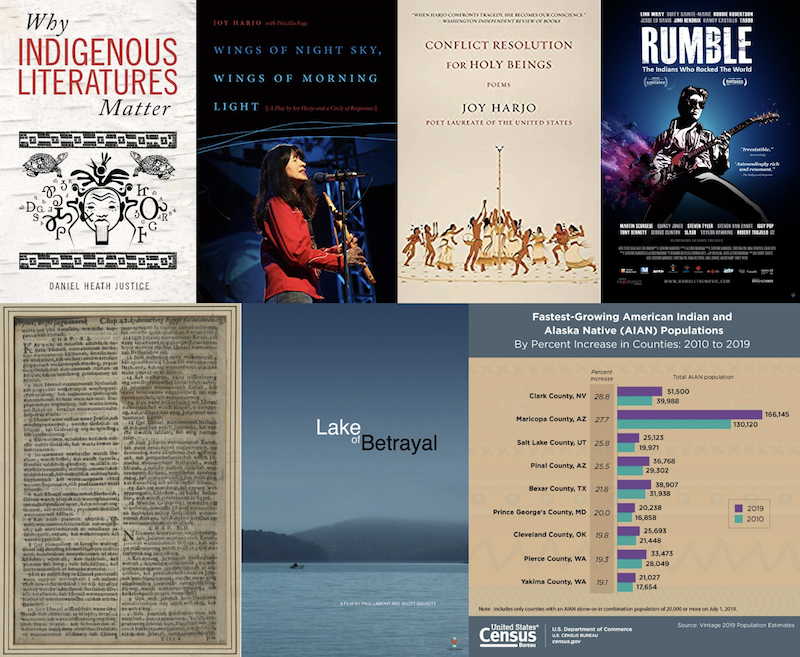University Libraries

Native American Heritage Month: History, Arts, Literature, Languages
By Kristina Schulz
What began over a century ago as a single day to recognize the contributions of the Indigenous peoples of the lands that became the United States is now a month devoted to honoring Native American heritage. This year marks the 30th anniversary of the celebration of Native American Heritage Month.
The U.S. Census Bureau has published a “Facts for Features” page on its website that presents statistics about American Indian and Alaska Native populations in the United States. The University Libraries also have many resources that celebrate the rich culture and traditions of Native Americans. Explore a sampling here, followed by additional resources curated by the Library of Congress, the Smithsonian Institution, PBS and other organizations.
From the Leisure Reading Collection
Wings of Night Sky, Wings of Morning Light: A Play by Joy Harjo and a Circle of Responses — By Joy Harjo and Priscilla Page (e-resource). Wings of Night Sky, Wings of Morning Light is the centerpiece of this collection, which includes essays and interviews concerning the roots and the reaches of contemporary Native Theater. (Goodreads)
Why Indigenous Literatures Matter — By Daniel Heath Justice. Part survey of the field of Indigenous literary studies, part cultural history, and part literary polemic, Why Indigenous Literatures Matter asserts the vital significance of literary expression to the political, creative and intellectual efforts of Indigenous peoples today. (Goodreads)
Conflict Resolution for Holy Beings: Poems — By Joy Harjo. In these poems, the joys and struggles of the everyday are played against the grinding politics of being human. Beginning in a hotel room in the dark of a distant city, the reader travels through history and follows the memory of the Trail of Tears. Stomp dance songs, blues and jazz ballads echo throughout. Lost ancestors are recalled, and resilient songs are born, even as people grieve the loss of their country. (Goodreads)
Films from Kanopy
Lake of Betrayal: Seneca People Fighting to Protect their Ancestral Lands — By Vision Maker Media. Completed in 1965, the Kinzua Dam on the Allegheny River in Pennsylvania was proposed to help mitigate flooding in Pittsburgh, 200 miles downriver; however, the 27-mile reservoir it formed inundated vast tracts of ancestral lands of the Seneca Nation, forcing removal in breach of the United States’ oldest treaty then in effect. This film looks at the Seneca Nation’s fight to protect its sovereignty from the overwhelming political and economic forces driving the post-World War II boom. (Kanopy)
Rumble: The Indians Who Rocked the World — By Kino Lorber. This documentary brings to light the profound yet often overlooked influence of Indigenous people on popular music in North America, focusing on musicians such as Link Wray, Jimi Hendrix, Buffy Sainte-Marie, Taboo (the Black Eyed Peas), Charley Patton, Mildred Bailey, Jesse Ed Davis, Robbie Robertson, and Randy Castillo. (Kanopy)
Rare books in University Archives
Several rare books in the University Archives and Special Collections are written in Native American languages.
Leaf from a 1663 Eliot Indian Bible: Jeremiah XL, XLII-XLIII — Now digitized and available for download from eCommons, this is the first Bible printed in what is now the United States and is in a Native American language. John Eliot, a Cambridge scholar, Christian missionary, translator and linguist, learned the Wôpanâak dialect of the tribes of colonial New England with the assistance of several native speakers. His New Testament translation was printed in 1661. Two years later, he completed the Old Testament in Wôpanâak. His translations documented a language that didn’t exist in written form before his translation. A video from the Museum of the Bible gives additional information about Eliot and his translations.
Prières, Cantiques, Catéchisme, etc., en Langue Crise — Text in Cree syllabics; title in French and Cree. This is a book of prayers and devotions.
Additional resources
- The Library of Congress, the National Archives and Records Administration, the National Endowment for the Humanities, the National Gallery of Art, the National Park Service, the Smithsonian Institution and the United States Holocaust Memorial Museum also honor the rich ancestry and traditions of Native Americans with an online collection of arts, history, archives, and audio and video features.
- The online exhibit Picturing the American Buffalo: George Catlin and Modern Native American Artists highlights works by Native American artists.
- PBS has assembled a collection of documentaries to celebrate Native American Heritage Month.
— Kristina Schulz is the University archivist.
